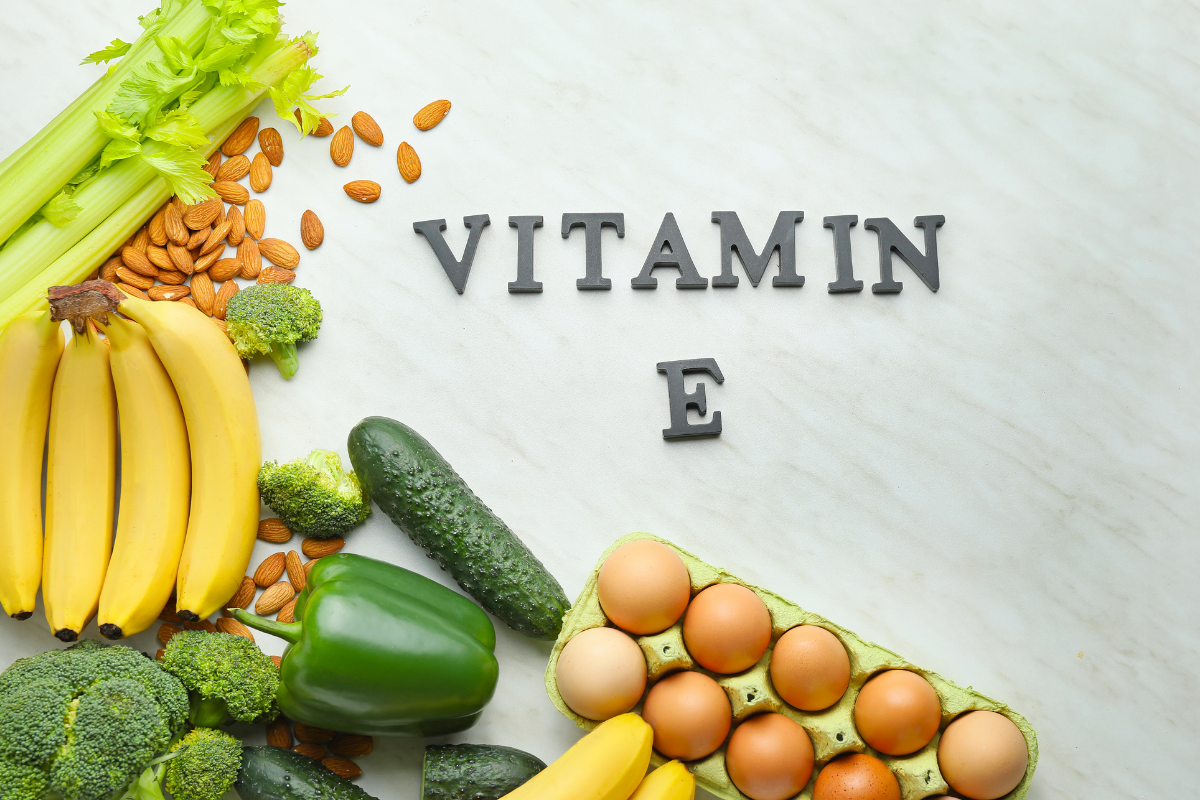Vitamin E: The valuable ally for good health

Table of Contents
What is Vitamin E?
Vitamin E is a fat-soluble vitamin that was discovered 100 years ago and plays a key role in maintaining the health of the human body. It has a strong antioxidant effect, protecting against the appearance of many pathological conditions. [1],[3]
There is a large number of publications on vitamin E. Most literature data focuses on one of its forms, α-tocopherol, leading to significantly less understanding of the other forms (e.g. tocotrienols) [5].
Vitamin E benefits
Among the most important functions of vitamin E are:
- antioxidants,
- anti-inflammatory,
- immunoregulatory
- and its neuroprotective abilities [1],[8].
In addition, it has been shown to contribute to the health of the skin and hair, while it is often used for relief in women with premenstrual syndrome.
Some of its potentially beneficial actions, for which a lot of research has been carried out, as well as their results, are briefly mentioned below.
Antioxidant protection
Oxidative stress is a condition resulting from the body’s inability to adequately deal with sources of oxidation and has been associated with a number of serious pathological conditions, as well as premature aging.
Vitamin E has a strong antioxidant effect, which means it protects cells from oxidative stress. Through this property, it contributes to the overall health of the body and prevents/slows down various adverse conditions.
Vitamin E for skin & hair health
The antioxidant vitamin E has been widely studied for its potential beneficial effect in improving the condition of the skin of the face and hair. It seems that it can prevent or slow down the progression of skin diseases (atopic dermatitis, acne, psoriasis), as well as improve the quality & rate of hair growth [6],[7].
Related research has identified a reduction in the rate of hair loss progression and faster hair growth in people taking a vitamin E supplement. In addition, it appears that skin and hair have a brighter & healthier appearance when Vitamin E is at desired levels, compared to when there is some degree of deficiency [6],[7].
Applying pure Vitamin E on the face offers multiple benefits. Indicatively, it manages: [9]
- Reduces hyperpigmentation (spots)
- Offers anti-aging action
- Reduces fine lines and wrinkles
- Treats acne
- Removes dark circles
Vitamin E can be applied topically or added to the composition of various skin cosmetic products.
However, it is extremely sensitive to high temperatures, light, oxygen and alkaline conditions, which somewhat limits its potential applications.
Slowing of cognitive decline
It is believed that vitamin E is likely to play a positive role in mild cognitive impairment (MCI) and the development of dementia. In several studies performed in humans and animals with MCI, low levels of tocopherol were observed [4].
However, the various epidemiological and clinical studies that have been carried out to date are not sufficient to say with certainty that vitamin E slows down the progression of mild cognitive impairment, preventing or delaying the onset of dementia [4].
Further clinical research is needed to adequately understand the safety & efficacy of vitamin E as a dietary supplement to promote healthy aging in humans [4]. Therefore, it is considered good practice to maintain desirable levels of vitamin E through diet alone.
Support of cardiovascular function
The antioxidant role of vitamin E in preventing and slowing the progression of adverse cardiovascular outcomes is controversial, with some studies supporting it while others reject it [2].
The majority of studies have failed to demonstrate that vitamin E intake plays a significant role in the prevention of cardiovascular disease and all-cause mortality.
Some studies even report that high levels of vitamin E can cause adverse cardiovascular effects. Therefore, special caution and guidance is needed regarding vitamin E supplementation to prevent cardiovascular risk [2].
Vitamin E forms
The term vitamin E is used to describe a group of 8 fat-soluble molecules with strong antioxidant activity, belonging to either the tocopherols or the tocotrienols. Specifically, vitamin E includes the following forms: alpha, beta, gamma and delta-tocopherol and alpha, beta, gamma and delta-tocotrienol.
The most important form for human health is α-tocopherol, as it is the only one that is abundant and well preserved in human plasma. Its importance has been demonstrated in both humans and animals with vitamin E deficiency [1].
In particular, it seems that, in addition to its antioxidant activity, α-tocopherol is necessary for various homeostatic processes (e.g. in the central nervous system) and for the functioning of the immune system [1].
On the other hand, the tocotrienols of natural vitamin E seem to contribute to the regulation of cholesterol levels and to have strong neuroprotective properties [5].
The abundance of α-tocopherol in the human body and its higher efficiency as an antioxidant, compared to other vitamin E molecules, led to the “neglect” of the remaining forms of the vitamin as an object of research [5].
Natural vitamin E found in foods is often listed as d-alpha-tocopherol on food labels and is more potent than that produced synthetically. The synthetic form is often referred to as dl-alpha-tocopherol [8].
Vitamin E supplements usually contain isomers of α-tocopherol and have about half the level of activity compared to natural sources.
In the trade, you will find it in nutritional supplements as:
- soft capsule
- liquid form (oil – drops)
- ampoule
- face cream
In addition, it is available in formulations together with Vitamin A, selenium or other antioxidant ingredients, to optimally combat oxidative stress and strengthen the immune system.
Vitamin E foods and sources
Vitamin E is found in a variety of foods, either naturally or by having it added to them (eg fortified cereals). Therefore, vitamin E deficiency is extremely rare [3].
Foods rich in vitamin E are the following:
Nuts
- almonds
- hazel
- sunflower seeds
- crooked
- pistachios
Plant sources
- vegetable oils (sunflower oil, olive oil, seed oil, almond oil etc.)
- kiwi
- avocado
- blueberries
- mango
- pumkin
Animal sources
- trout
- salmon
- snails
- fish eggs
- eggs
Tocopherols are predominant in most vegetable oils (olive oil, sunflower oil, soybean oil, corn oil), while tocotrienols are the main vitamin E components of palm oil, barley and rice bran [5].
Vitamin E deficiency symptoms
Vitamin E deficiency is very rare and mainly concerns:
- people with specific genetic disorders
- and very low birth weight premature infants.
In these cases, the situation is evaluated and vitamin E supplements are administered, in the content & form deemed necessary and safe per case [3].
Because the digestive system requires fat to absorb vitamin E, people with fat malabsorption disorders are more often deficient than the general population. A typical example is people with Crohn’s disease, cystic fibrosis or inability to secrete bile from the liver into the digestive system [3].
Premature infants with very low birth weight (<1.5 kg) are often deficient in vitamin E. Vitamin E supplementation in these infants may reduce the risk of some complications (e.g. retinal), but appears to increase the risk of infections [3].
Symptoms that indicate low levels of vitamin E are relatively vague and may include:
- difficulty in walking,
- muscle pain,
- generalized weakness
- & malaise and vision problems [3].
Severe deficiency can lead to:
- peripheral neuropathy,
- skeletal myopathy,
- retinopathy,
- disorder
- and weakening of the immune response [3].
Recommended Daily Intake (RDI)
The amount that is recommended to be consumed on a daily basis is called the Recommended Daily Amount (RDA).
The SPC for Natural Vitamin E:
- In adults and children over 14 years of age: it is 15 mg (22 IU)
- During pregnancy: 15 mg (22 IU)
- During breastfeeding: 19 mg (28 IU) [3].
Children under the age of 14 need a smaller dose on a daily basis:
- 1 to 3 years: 6 mg/day
- 4 to 8 years: 7 mg/day
- 9 to 13 years: 11 mg/day
It is worth noting that the doses of natural vitamin E and dl-alpha tocopherol that has been prepared in the laboratory are calculated differently, which can cause confusion when the vitamin is taken through a dietary supplement.
Vitamin E overdose
No adverse effects have been found from high consumption of vitamin E through diet. However, supplementing with high doses of α-tocopherol is potentially dangerous as it may increase the risk of bleeding and more [3],[8].
In particular, it has been shown that excessive intake of vitamin E, through dietary supplements, can interrupt blood clotting and lead to uncontrollable bleeding. In addition, it can reduce the production of thyroid hormones and increase the risk of hemorrhagic stroke [8].
For this reason, it is recommended to avoid taking food supplements with vitamin E, as long as there is no deficiency. In the case of taking a supplement, it is recommended to choose one that does not have a significantly higher content than the recommended daily dose (RDA) [3].
It is worth pointing out that overdosing on Vitamin E on a daily basis for a long period of time can be particularly dangerous. [8]
Vitamin E side effects & interactions
Taking vitamin E in high amounts may interact with blood clotting medication. Therefore, people taking one or more pharmaceutical products should inform their doctor before taking a vitamin E dietary supplement[3].
It is also necessary to inform the attending physician in case of pregnancy and breastfeeding. In the above cases, taking high doses of vitamin E, is recommended to be avoided if there is no substantial need.
In specific cases, particularly increased caution is recommended regarding the intake of nutritional supplements with vitamin E, as there is a high risk of complications. In particular, it is recommended that people with:
- bleeding disorders,
- cardiovascular problems,
- diabetes,
- history of heart attack
- and/or osteoporosis [3].
Finally, it is important not to take vitamin E for at least 2 weeks before a scheduled surgery to avoid the possibility of bleeding during or after surgery.
References:
Disclaimer
The content of this blogspot is not and can not be considered as medical advice, diagnosis or treatment. All information is provided to readers solely for informational purposes. There is no intention to substitute this content for personalized medical advice, diagnosis, prognosis or treatment.






Leave a comment